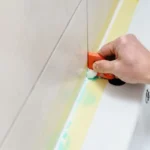Reducing kitchen and bathroom carbon footprint guide, Sustainable and eco-friendly remodeling advice, Property style tips
Sustainable and Eco-Friendly Remodeling: Tips for Reducing Your Carbon Footprint in the Kitchen and Bathroom
2 April 2024
Every choice we make today impacts the world around us. That means transforming our homes into sustainable models is more than a trend. It is a necessity!
Our environment requires our care and respect to thrive. As part of a sustainable remodeling emphasis, let’s take a few moments to rethink how we live.
It is possible to decrease our environmental footprint while creating healthier, more energy-efficient kitchens and bathrooms.
How to Incorporate Eco-Friendly Materials into a Renovation
A remodeling project that emphasizes its environmental impact is good for the home and the planet. Whether you’re contemplating a complete makeover or sprucing up a couple of rooms, you’ll find plenty of options for incorporating sustainable materials and practices.
The first step is to select your sustainable building materials. Three excellent choices to consider are bamboo, recycled wood, and cord.
Bamboo grows quickly, making it a sustainable choice because it keeps your carbon footprint down. In some cases, you can use it for flooring, cabinetry, and even as a structural material. It’s durable, looks fantastic, and gives your space a warm, natural vibe.
You can reclaim materials from furniture, beams, or floors with recycled wood to create a unique charm that new products cannot match. Simultaneously, you’re preserving forest biomes by reducing demand in the marketplace for cutting down trees.
Cork is an excellent choice because it is renewable and recyclable. It works well for insulation and is also an option for wall coverings or flooring. As an extra benefit, it comes with natural antimicrobial qualities.
Insulation Choices That Lead to Eco-Friendly Results
Insulation products are an essential component of an energy-efficient renovation project. The selected materials in this category work to keep your home warm in the winter and cooler in the summer.
A top pick for insulation upgrades is sheep’s wool. It’s a renewable resource that naturally absorbs and releases moisture, which can help regulate humidity levels within each room. It even has a pollutant-absorption quality that purifies the indoor air.
Another insulation choice that is rising in popularity is recycled denim. It’s made from post-consumer fabric that gets diverted from local landfills. It’s treated as fire and pest-resistant and then spun into insulation batts, making it safe to handle without protective gear.
Hemp is another eco-friendly choice because it is a low-impact crop. Insulation is made from the plant’s fibers, bound together to form panels or batts. It’s an excellent choice for those looking for acoustic-dampening properties.
What Energy-Efficient Solutions Are Worth Pursuing?
Once you have selected renewable products and insulation for your home renovation, several additional upgrades are available to improve the structure’s energy efficiency ratings.
Since each home has unique needs, consider the ones that make the most sense in your situation.
- Seal the Ductwork. Leaking ducts can lead to significant energy losses. Up to 30% of the modified air can escape through holes or poor connections, so take this step to ensure it gets appropriately distributed to each room.
- Upgrade the Windows. Replacing old, leaky windows with energy-efficient ones can greatly improve your home’s thermal performance. To achieve the best results, look for products that offer low-E coatings, double or triple glazing, and inert gas between the panes.
- High SEER HVAC Systems. If your heating, ventilation, and air conditioning system is inefficient or more than ten years old, upgrading it can deliver significant energy savings. The best options have a high AFUE rating while promoting an excellent seasonal energy efficiency ratio.
- Use Low-Flow Water Fixtures. Less water usage can reduce a home’s overall energy consumption, especially when electric water heaters, dishwashers, and softeners are part of its infrastructure.
- Add Natural Light. Incorporating more sunshine in a home reduces the need for artificial lighting and can support temperature stability. Consider adding skylights, larger windows, or solar tubes as part of the renovation process.
Finally, an older home could benefit from targeted automation technology upgrades. Smart thermostats are a popular choice, although they might not be for those with baseboard heating. Automated blinds can regulate temperatures, while power strips can turn off the standby power to devices not being used.
Practical Tips for Reducing Waste and Conserving Energy
Before starting a renovation project, it helps to take some time to plan the process with sustainable ideas. Think about how you can reuse some materials, minimize waste, and reduce energy consumption now and in the future.
Once you have a blueprint to follow, here are a few ideas to help you reduce the amount of waste produced by the work.
1. Deconstruct Unwanted Items
Whenever possible, deconstruct the items you’re removing instead of demolishing them. Carefully removing these things can allow you to reuse or donate them, reducing waste that goes to the local landfill. Materials like wood, fixtures, and even nails and screws can often be repurposed.
2. Donate Unnecessary Items
Before you toss old fixtures, cabinets, or appliances, see if they can be donated. Many organizations accept used items in good condition, giving them a new life and reducing the quantity of products in the local trash management stream.
3. Recycle the Debris
Recycling is the next best option for materials that can’t be reused or donated. Many construction materials, such as metal, cardboard, and certain plastics, can be managed this way. Your local recycling center can provide information about the local guidelines to follow.
If you’re generating a lot of waste with a remodeling project, consider renting a separate dumpster for recyclables. This makes it easier to divert materials from the landfill and ensures that the items are properly processed.
4. Use Energy-Efficient Tools
As you work on the renovation project, consider investing in LED work lights and power tools with ENERGY STAR ratings. Working during the day to take advantage of the sunlight can reduce reliance on artificial lighting, adding to the savings.
While the work is happening, look for low-flow toilets, faucets, and showerheads to reduce water use. It might make sense to upgrade to a tankless water heater or choose high-efficiency appliances.
5. Dispose of Hazardous Items Appropriately
Some items are not recyclable or reusable. If you have hazardous materials to remove, like solvents, paint, or certain lightbulbs, it helps to dispose of them correctly to avoid environmental harm.
Your next remodeling project is a chance to make a long-lasting, positive impact on the planet while beautifying your space. From innovative insulation choices to energy-saving upgrades, there is enormous potential to reduce waste and conserve energy. Now is your moment to show that home improvements can be beautiful and environmentally responsible.
Together, we can build a future where every home contributes to the health of our planet.
Comments on this guide to Sustainable and Eco-Friendly Remodeling: Tips for Reducing Your Carbon Footprint in the Kitchen and Bathroom article are welcome.
Painting Your Home
Painting Your House Posts
Acrylic Painting Materials To Include In Your Studio
Tips and tricks when repainting your house
Things You Should Know About Painting Your Home
Building Articles
Residential Architecture
Comments / photos for the Reducing kitchen and bathroom carbon footprint at home advice page welcome



